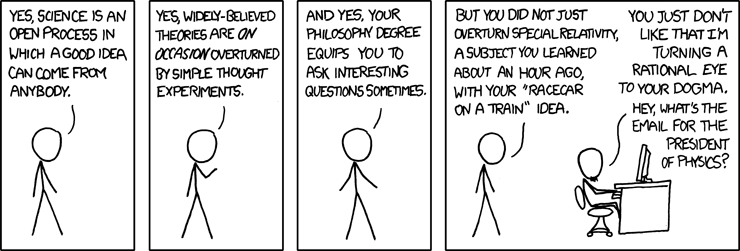Have you been to promotingjesus.org? Why not. It’s Mitchelton Presbyterian Church’s new evangelistic tool – they’re spending a year encouraging people to promote Jesus. It’s a great resource.
My future brother-in-law, Mitch, put most of it together. He’s done a great job. I am writing a few articles there. There’s one up already and here’s one I’ve just written (that’ll no doubt be edited before going live).
Jesus ignores science
There are many people – both from the scientific and Christian communities – who would take this statement to a further extreme. They would argue that being a follower of Jesus means rejecting science. And certainly, science is ultimately a fallible human product. It is not perfect. To hold what we now think we know to be absolutely true (based on science) is dangerous ground. This is why scientific principles are called theories. Science is always waiting for a better explanation. A more complete picture.
Jesus did not ignore science. Jesus does not contradict science – and in fact you can hold to scientific truth and still be a Christian – providing you are willing to submit to the idea that Jesus, as God, is not bound by the rules that apply to you and I. Our null hypothesis as believers – the point at which all scientific theories begin – is that there is a God who has influence over the way the world works.
The truth of Christianity doesn’t pivot on a great conflict between scientific beliefs like evolution and contrary claims in the Bible. The truth of Christianity hangs on the person of Jesus. Did he exist? Did he perform the miracles the Bible claims he did? Did he die and rise?
There is a scientific element to these questions – but more than any other religion – Christianity submits its claims to the scientific method for observation and testing. Jesus started by posing a hypothesis. He asks us to test his claims that he is the son of God and the saviour of mankind. His ministry was measurable and observable. It occurred in public in front of tens of thousands of witnesses around the regions he travelled. His miracles were repeatable – they were not – based on the accounts of his life – one offs.
Those around Jesus were able to measure and observe – and had his claims been bunkum they would have been able to refute them. But time and time again those in positions most likely to refute his actions – for example his sparring partners the Pharisees – were left having to accept that there was something unique about him.
No other religion subjects its deity to such scientific scrutiny. Jesus was tangible, he was tactile. The resurrection is without doubt the hardest claim for us to accept based on current scientific knowledge. We know people don’t just rise from the dead. This is where the hypothesis that there is a God involved becomes important.
If Christians claim that Jesus rose from the dead – a claim seemingly counter to our scientific principles – then this is where science and Christianity collide. The resurrection of Jesus is a question of history not a question of science. Did it happen? If it did then it must influence our understanding of science. We must accept that Jesus was who he claimed to be.
The scientific method is relatively young. The model we understand and apply when testing truths is the product of the 19th century enlightenment. People were no less skeptical of claims of resurrection prior to the enlightenment. We’ve always had a sense that rising from the dead is an extraordinary occurrence. Even the religious people of Jesus’ day didn’t necessarily believe in the possibility of the resurrection of the dead – Paul uses this division when he’s on trial in Acts chapter 23.
While the scientific method wasn’t around while Jesus was alive, God knows the type of questions people ask. And so we meet Thomas – often called “Doubting Thomas” but perhaps more appropriately “Scientific Thomas”.
Thomas was a disciple. He’d travelled with Jesus for years. He had heard Jesus say (a few times) that he would die and be raised from the dead. It seems he didn’t believe this was possible.
After Jesus had died and been raised he appeared to the other disciples and ate some food. But Thomas wasn’t there – and he didn’t believe the claims his friends (the other disciples) made about their meeting with Jesus.
So when Thomas was confronted by the resurrected Jesus his first thoughts were the same that ours would be if we were confronted by a friend we knew was dead. Thomas had seen Jesus die, he knew he had been buried. So he thought he was hallucinating. He thought, perhaps, he was being confronted with a ghost. He didn’t believe in that sort of stuff so he put it to the test. He conducted an experiment.
This is the story John’s gospel ends with – an account of the scientific testing of the resurrection and the belief of a skeptic… in chapter 20…
Jesus Appears to Thomas
24 Now Thomas (called Didymus), one of the Twelve, was not with the disciples when Jesus came. 25 So the other disciples told him, “We have seen the Lord!”
But he said to them, “Unless I see the nail marks in his hands and put my finger where the nails were, and put my hand into his side, I will not believe it.”
26 A week later his disciples were in the house again, and Thomas was with them. Though the doors were locked, Jesus came and stood among them and said, “Peace be with you!” 27 Then he said to Thomas, “Put your finger here; see my hands. Reach out your hand and put it into my side. Stop doubting and believe.”
28 Thomas said to him, “My Lord and my God!”
29 Then Jesus told him, “Because you have seen me, you have believed; blessed are those who have not seen and yet have believed.”
Jesus does not ignore science – though he could be forgiven for doing so because the scientific method wasn’t around when he was – Jesus submits his claims to science, and he triumphs over science. True knowledge and understanding of the world comes from an understanding of the one who created the world – and the one who triumphs over the realities of the world – death and our inability to live meeting God’s standard.

![[geekmap.png]](http://1.bp.blogspot.com/_NfKwjR8raUA/SxhAY0izYUI/AAAAAAAAAHs/79k3_xw4dHg/s1600/geekmap.png)
 Posted by: Nancy
Posted by: Nancy  Posted by: Frederic Lardinois
Posted by: Frederic Lardinois 










